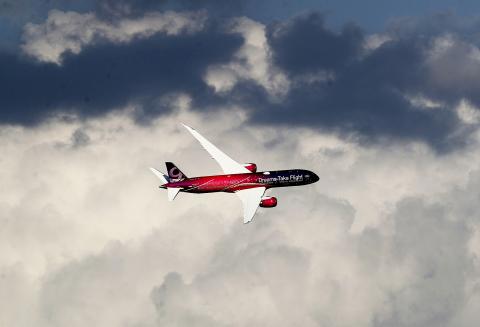Abu Dhabi’s flagship carrier Etihad Airways PJSC yesterday announced that it is launching one of the world’s most fuel-efficient long-haul airplanes as it seeks to save costs on fuel and position itself as a more environmentally conscious choice for travelers.
Etihad’s “Greenliner” is a Boeing Co 787 Dreamliner that is to depart on its first route from Abu Dhabi to Brussels in January.
Etihad chief executive officer Tony Douglas described the aircraft as a flying laboratory for testing that could benefit the entire industry.

Photo: AP
With fuel costs eating up about one-quarter of airline spending, Douglas said the goal of the Greenliner is to be 20 percent more fuel efficient than other aircraft in Etihad’s fleet.
“This is not just a box-ticking exercise,” he told reporters at the unveiling of the initiative at the Dubai Airshow alongside executives from Boeing.
Douglas said the aircraft “not only makes sense economically from a profit and loss account point of view, but because it also directly impacts the CO2 because of the fuel burn.”
Etihad has reported losses of US$4.75 billion since 2016 as its strategy of aggressively buying stakes in airlines from Europe to Australia exposed the company to major risks.
Despite its financials, the airline continues to be among the most innovative.
This year, Etihad flew the world’s first passenger flight using sustainable biofuel made from a plant that grows in saltwater.
It also became the first in the Middle East to operate a flight without any single-use plastics on board to raise awareness of the effects of plastic pollution.
Etihad said it plans to make the Greenliner a “social media star” to bring under sharper focus its developments and achievements worldwide.
Douglas said anything that Eithad learns with Boeing from the aircraft’s operations would be open-domain knowledge, “because it’s about moving the industry forward in a responsible fashion.”
The Greenliner would be the only aircraft of its kind in Etihad’s fleet of Dreamliners. The company has 36 of the 787s in its fleet, with plans to operate 50.
“This is a small step today, but in a very, very long journey,” Douglas said.

With this year’s Semicon Taiwan trade show set to kick off on Wednesday, market attention has turned to the mass production of advanced packaging technologies and capacity expansion in Taiwan and the US. With traditional scaling reaching physical limits, heterogeneous integration and packaging technologies have emerged as key solutions. Surging demand for artificial intelligence (AI), high-performance computing (HPC) and high-bandwidth memory (HBM) chips has put technologies such as chip-on-wafer-on-substrate (CoWoS), integrated fan-out (InFO), system on integrated chips (SoIC), 3D IC and fan-out panel-level packaging (FOPLP) at the center of semiconductor innovation, making them a major focus at this year’s trade show, according

DEBUT: The trade show is to feature 17 national pavilions, a new high for the event, including from Canada, Costa Rica, Lithuania, Sweden and Vietnam for the first time The Semicon Taiwan trade show, which opens on Wednesday, is expected to see a new high in the number of exhibitors and visitors from around the world, said its organizer, SEMI, which has described the annual event as the “Olympics of the semiconductor industry.” SEMI, which represents companies in the electronics manufacturing and design supply chain, and touts the annual exhibition as the most influential semiconductor trade show in the world, said more than 1,200 enterprises from 56 countries are to showcase their innovations across more than 4,100 booths, and that the event could attract 100,000 visitors. This year’s event features 17

EXPORT GROWTH: The AI boom has shortened chip cycles to just one year, putting pressure on chipmakers to accelerate development and expand packaging capacity Developing a localized supply chain for advanced packaging equipment is critical for keeping pace with customers’ increasingly shrinking time-to-market cycles for new artificial intelligence (AI) chips, Taiwan Semiconductor Manufacturing Co (TSMC, 台積電) said yesterday. Spurred on by the AI revolution, customers are accelerating product upgrades to nearly every year, compared with the two to three-year development cadence in the past, TSMC vice president of advanced packaging technology and service Jun He (何軍) said at a 3D IC Global Summit organized by SEMI in Taipei. These shortened cycles put heavy pressure on chipmakers, as the entire process — from chip design to mass

Germany is to establish its first-ever national pavilion at Semicon Taiwan, which starts tomorrow in Taipei, as the country looks to raise its profile and deepen semiconductor ties with Taiwan as global chip demand accelerates. Martin Mayer, a semiconductor investment expert at Germany Trade & Invest (GTAI), Germany’s international economic promotion agency, said before leaving for Taiwan that the nation is a crucial partner in developing Germany’s semiconductor ecosystem. Germany’s debut at the international semiconductor exhibition in Taipei aims to “show presence” and signal its commitment to semiconductors, while building trust with Taiwanese companies, government and industry associations, he said. “The best outcome